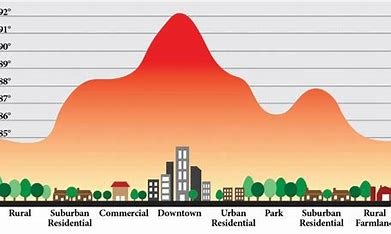Cities worldwide are grappling with the detrimental effects of the urban heat island (UHI) phenomenon, which leads to dangerously high temperatures during summer months. However, a recent study conducted by Penn State researchers offers hope in the form of urban design interventions that can alleviate this issue. Published in Buildings, the research highlights the role of specific urban factors in reducing the UHI effect and improving thermal comfort levels.
One of the key findings of the study is the significant cooling effect provided by trees. The presence of trees was found to lower outdoor air temperature, mean radiant temperature, and the predicted mean vote index—a metric used to evaluate thermal comfort. However, the study also revealed that the cooling benefits of trees are limited to their immediate surroundings. Areas devoid of trees experienced substantially higher mean radiant temperatures, emphasizing the importance of tree coverage in mitigating UHI.
Additionally, the researchers identified two other crucial factors: higher building-height-to-street-width ratios and pavement with high albedo (ability to reflect sunlight). Tall buildings casting shade on narrower streets and reflective pavement were associated with lower mean radiant temperatures and increased comfort levels. These findings pave the way for adopting measures that promote favorable temperatures in cities, with a particular focus on disadvantaged communities, people of color, and the elderly, who bear the brunt of the UHI effect disproportionately.
The study was conducted in Philadelphia—a city known for its high poverty rates and extreme weather events. By leveraging data on social vulnerability and tree coverage, researchers created 3D models of two neighborhoods with contrasting characteristics. Simulations were then run for various scenarios, considering seasonal variations and extreme temperature conditions, to assess the impact of different factors on thermal conditions.
The implications of this research extend beyond Philadelphia, as the findings emphasize the importance of urban morphology and vegetation coverage in designing sustainable and livable cities. The integration of taller buildings and high-albedo pavements can be considered to create more comfortable thermal environments, especially in areas with limited vegetation. The study also highlights the need for future research to incorporate data from diverse climate zones and indoor thermal comfort, enabling a comprehensive understanding of the relationship between urban properties, climate variations, and social vulnerability indexes.
By adopting these research-backed urban design strategies, cities can effectively combat the UHI effect and enhance resilience against extreme heat. This interdisciplinary approach promotes equity and inclusivity by addressing the thermal challenges faced by marginalized communities. Ultimately, it paves the way for more sustainable and livable urban environments that prioritize the well-being of all residents.

